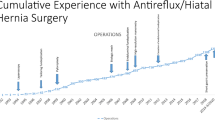Abstract
Background
Hiatal hernia repair performed at the time of laparoscopic sleeve gastrectomy (LSG) may reduce post-operative reflux symptoms. It is unclear whether intra-operative diagnosis of hiatal hernia varies among surgeons or if it affects outcomes.
Study design
Surgeons (n = 38) participating in a statewide bariatric surgery quality improvement collaborative reviewed 33 videos of LSG in which no hiatal hernia repair was performed. Reviewers were blinded to patient information and were asked whether they perceived a hiatal hernia. Surgeon characteristics and surgeon-specific patient outcomes for LSG were compared between surgeons who identified at least one hiatal hernia during video review and those who did not.
Results
Ten surgeons (26%) identified at least one hiatal hernia after reviewing the videos. There were no significant differences in operative experience or practice type between surgeons who did and did not identify hiatal hernias. Surgeons who identified a hiatal hernia more often performed concurrent hiatal hernia repair in their practice when compared to those who did not (43.0% versus 36.5%, p < 0.001). Although complication rates were similar between surgeon groups, there were higher rates of de novo reflux symptoms (13.6% versus 11.1%, p = 0.032) and lower rates of antacid discontinuation at one-year (71.0% versus 77.2%, p = 0.043) among surgeons who identified hiatal hernias.
Conclusion
Surgeons who identified hiatal hernias during video review had a higher rate of concurrent hiatal hernia repairs in their practice. This was not associated with improved patient-reported reflux symptoms after LSG. Standardizing identification and management of hiatal hernias during bariatric surgery may help improve reflux outcomes post-operatively.

Similar content being viewed by others
Abbreviations
- LSG:
-
Laparoscopic sleeve gastrectomy
- GERD:
-
Gastroesophageal reflux disease
- UGI:
-
Upper gastrointestinal series
- EGD:
-
Esophagogastroduodenoscopy
- MBSC:
-
Michigan Bariatric Surgery Collaborative
- GERD-HRQL:
-
Gastroesophageal Reflux Disease-Health Related Quality of Life
- BMI:
-
Body mass index
References
Varela JE, Nguyen NT (2015) Laparoscopic sleeve gastrectomy leads the US utilization of bariatric surgery at academic medical centers. Surg Obes Related Dis 11:987–990
Reames BN, Finks JF, Bacal D, Carlin AM, Dimick JB (2014) Changes in bariatric surgery procedure use in Michigan, 2006–2013. JAMA 312:959–961
Estimate of Bariatric Surgery Numbers, 2011–2017. American Society for Metabolic and Bariatric Surgery.
Hutter MM et al (2011) First report from the American College of Surgeons Bariatric Surgery Center Network: laparoscopic sleeve gastrectomy has morbidity and effectiveness positioned between the band and the bypass. Ann Surg 254:410–420
Patti MG, Schlottmann F (2018) Gastroesophageal reflux after sleeve gastrectomy. JAMA Surg 153:1147–1148
Peterli R et al (2018) Effect of laparoscopic sleeve gastrectomy vs laparoscopic Roux-en-Y gastric bypass on weight loss in patients with morbid obesity: the SM-BOSS Randomized Clinical Trial. JAMA 319:255–265
Lyon A, Gibson SC, De-loyde K, Martin D (2015) Gastroesophageal reflux in laparoscopic sleeve gastrectomy: hiatal findings and their management influence outcome. Surg Obes Related Dis 11:530–537
Varban OA et al (2019) Surgeon variation in severity of reflux symptoms after sleeve gastrectomy. Surg Endosc 34:1769
Kohn GP et al (2013) Guidelines for the management of hiatal hernia. Surg Endosc 27:4409–4428
Melissas J et al (2015) Gastroesophageal reflux disease and sleeve gastrectomy. Obes Surg 25:2430–2435
Mizrahi I et al (2019) Routine upper gastrointestinal fluoroscopy before laparoscopic sleeve gastrectomy: is it necessary? Obes Surg 29:1704–1708
Birkmeyer NJ et al (2005) Partnering with payers to improve surgical quality: the Michigan plan. Surgery 138:815–820
Share DA et al (2011) How a regional collaborative of hospitals and physicians in Michigan cut costs and improved the quality of care. Health Aff (Project Hope) 30:636–645
Velanovich V (2007) The development of the GERD-HRQL symptom severity instrument. Dis Esophagus 20:130–134
Siegal SR, Dolan JP, Hunter JG (2017) Modern diagnosis and treatment of hiatal hernias. Langenbeck's Arch Surg 402:1145–1151
Yates RB, Oelschlager BK (2015) Surgical treatment of gastroesophageal reflux disease. Surg Clin N Am 95:527–553
Peters JH (2013) SAGES guidelines for the management of hiatal hernia. Surg Endosc 27:4407–4408
Dakour Aridi HN, Tamim H, Mailhac A, Safadi BY (2017) Concomitant hiatal hernia repair with laparoscopic sleeve gastrectomy is safe: analysis of the ACS-NSQIP database. Surg Obes Related Dis 13:379–384
Samakar K et al (2016) The effect of laparoscopic sleeve gastrectomy with concomitant hiatal hernia repair on gastroesophageal reflux disease in the morbidly obese. Obes Surg 26:61–66
Stefanidis D et al (2010) Guidelines for surgical treatment of gastroesophageal reflux disease. Surg Endosc 24:2647–2669
Soricelli E et al (2013) Sleeve gastrectomy and crural repair in obese patients with gastroesophageal reflux disease and/or hiatal hernia. Surg Obes Related Dis 9:356–361
Author information
Authors and Affiliations
Corresponding author
Ethics declarations
Disclosures
This study received support from AHRQ 1R01HS023597-01 (Video Analysis for Ensuring Safer Diffusion of New Procedures) and the Michigan Bariatric Surgery Collaborative (Blue Cross Blue Shield of Michigan). Dr. Justin Dimick is a consultant & equity owner at ArborMetrix, Inc, which had no role in the work herein. Dr. Oliver Varban receives salary support from Blue Cross Blue Shield of Michigan for his role as co-director of the Michigan Bariatric Surgery Collaborative. Dr. Karan Chhabra is a participant in the IHPI National Clinician Scholars Program. Dr. Anne Ehlers and Dr. Jyothi Thumma have no additional conflicts of interest or financial ties to disclose.
Additional information
Publisher's Note
Springer Nature remains neutral with regard to jurisdictional claims in published maps and institutional affiliations.
Rights and permissions
About this article
Cite this article
Ehlers, A.P., Chhabra, K., Thumma, J.R. et al. In the eye of the beholder: surgeon variation in intra-operative perceptions of hiatal hernia and reflux outcomes after sleeve gastrectomy. Surg Endosc 35, 2537–2542 (2021). https://doi.org/10.1007/s00464-020-07668-4
Received:
Accepted:
Published:
Issue Date:
DOI: https://doi.org/10.1007/s00464-020-07668-4




